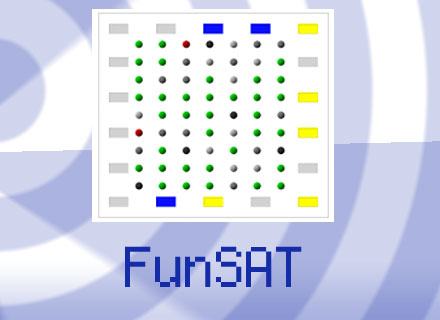Not only do some video games improve a person’s hand-eye co-ordination but certain games even promote pro-social behaviour in players. Now, we have word that a new computer game prototype, called FunSAT will utilize human intuition to solve the fundamental problem prevalent in many computer hardware design tasks. The online logic puzzle could potentially help integrated circuit designers to arrange and select transistors and their connections on silicon microchips.

Currently, computers handle the task of designing small and powerful micro chip architecture. However, computers sometimes overlook certain possible arrangements in their search because they lack human abilities of intuition and visual pattern recognition. Basically, FunSAT is designed to exploit human capacities of strategizing, understanding complex systems and visualizing.
The prototype has been developed by University of Michigan computer science researchers Andrew DeOrio and Valeria Bertacco. You need not be a rocket scientist or in this case, a computer scientist to play the game as it is based on the same lines as the popular Sudoku puzzle games.
An associate professor in computer science and engineering, Bertacco explained, “Computer games can be more than a fun diversion. Humans are good at playing games and they enjoy dedicating time to it. We hope that we can use their strengths to improve chip designs, databases and even robotics.”
The FunSAT board consists of many columns and rows of red, gray and green bubbles in different sizes. Buttons present around the perimeter can be turned blue or yellow with the click of a mouse. The color of a button determines the color of bubbles on the board. The objective here is to use the buttons present on the perimeter to toggle all the bubbles green. Users can contribute to the design of complex computer systems by solving difficult problems on the FunSAT board. Once solved, a computer scientist can simply look at the color of each button to figure out the answer to a specific problem.
The game features some classic and highly complicated mathematical questions that involve selecting the best arrangement possible. The puzzle solver must assign a set of variables to the right true or false categories in order to fulfill all the basic constraints of the problem. These constraints are represented by bubbles while the variables are represented by the perimeter buttons. Bubbles become green when they are satisfied and perimeter buttons are assigned to true or false when players click the mouse to make them yellow (true) or blue (false).
Hints about what to do next are given when the player right-clicks a bubble. A large bubble controls more buttons and each of these buttons affect other bubbles at the same time and in different ways. A button that turns several bubbles green is also bound to turn other bubbles from green to gray or even red.
“When solving these problems, humans can use their intuition and visualization skills. For instance, by just glancing at the neighborhood map they can gain an intuition of where to begin in the case of the postal route. FunSAT can leverage these human skills that computer-based solvers do not have,” commented Bertacco.
The game prototype is implemented in Java by University of Michigan undergraduate, Erica Christensen and is available for free on FunSAT’s official website. A multi-player game currently being developed by Bertacco and DeOrio would allow even more complicated problems to be solved.

